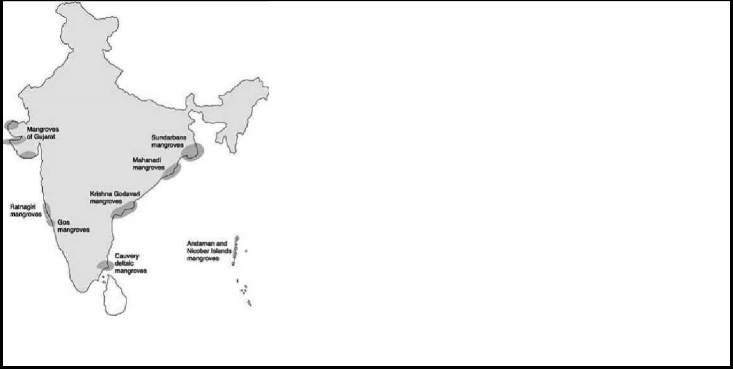4.7.2. Mangrove profile in India
♤ The mangroves of Sundarbans are the largest single block of tidal holophytic mangroves of the world. The major species of this dense mangrove forest include Herritiera fames, Rhizophora spp., Bruguiera spp., Ce-riops decandra, Sonneratia spp. and Avicennia spp., Nypa fruticans are found along the creeks. This mangrove forest is famous for the Royal Bengal Tiger and crocodiles. Mangrove areas are being cleared for agricultural use.
♤ The mangroves of Bhitarkanika (Orissa), which is the second largest in the Indian sub continent, harbour high concentration of typical mangrove species and high genetic diversity.
♤ Mangrove swamps occur in profusion in the intertidal mudflats on both side of the creeks in the Godavari-Krishna deltaic regions of Andhra Pradesh.
♤ Mangroves of Pichavaram and Vedaranyam are degraded mainly due to construction of aquaculture ponds and salt pans.

Indian Mangrove Profile

♤ On the west coast of India, mangroves, mostly scrubby and degraded occur along the intertidal region of estuaries and creeks in Maharashtra, Goa and Karnataka.
♤ The mangrove vegetation in the coastal zone of Kerala is very sparse and thin.
♤ In Gujarat (north-west coast) mangroves Avicennia marine, Avicennia officinalis and Rhizophora mucronata are found mainly in Gulf of Kachchh and the Kori creek.
♤ Mangroves are of scrubby type with stunted growth, forming narrow, discontinuous patches on soft clayey mud.
♤ The condition of the mangroves is improving especially in the Kori creek region, which is a paleodelta of the Indus river.
♤ In size, mangroves range from bushy stands of dwarf mangroves found in Gulf of Kuchchh, to taller stands found in the Sunderbans.
♤ On the Andaman & Nicobar Islands, the small tidal estuaries, neritic inlets and the lagoons support a dense and diverse undisturbed mangrove flora.
